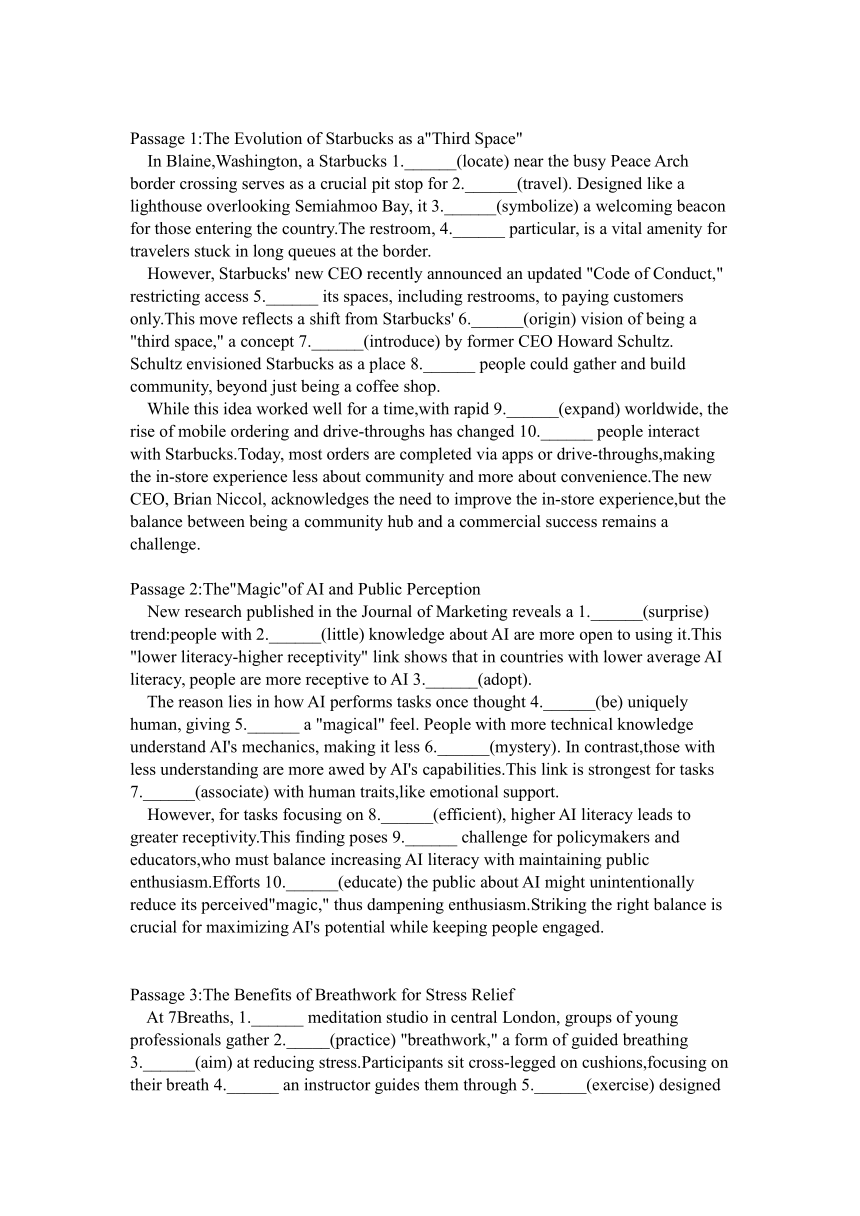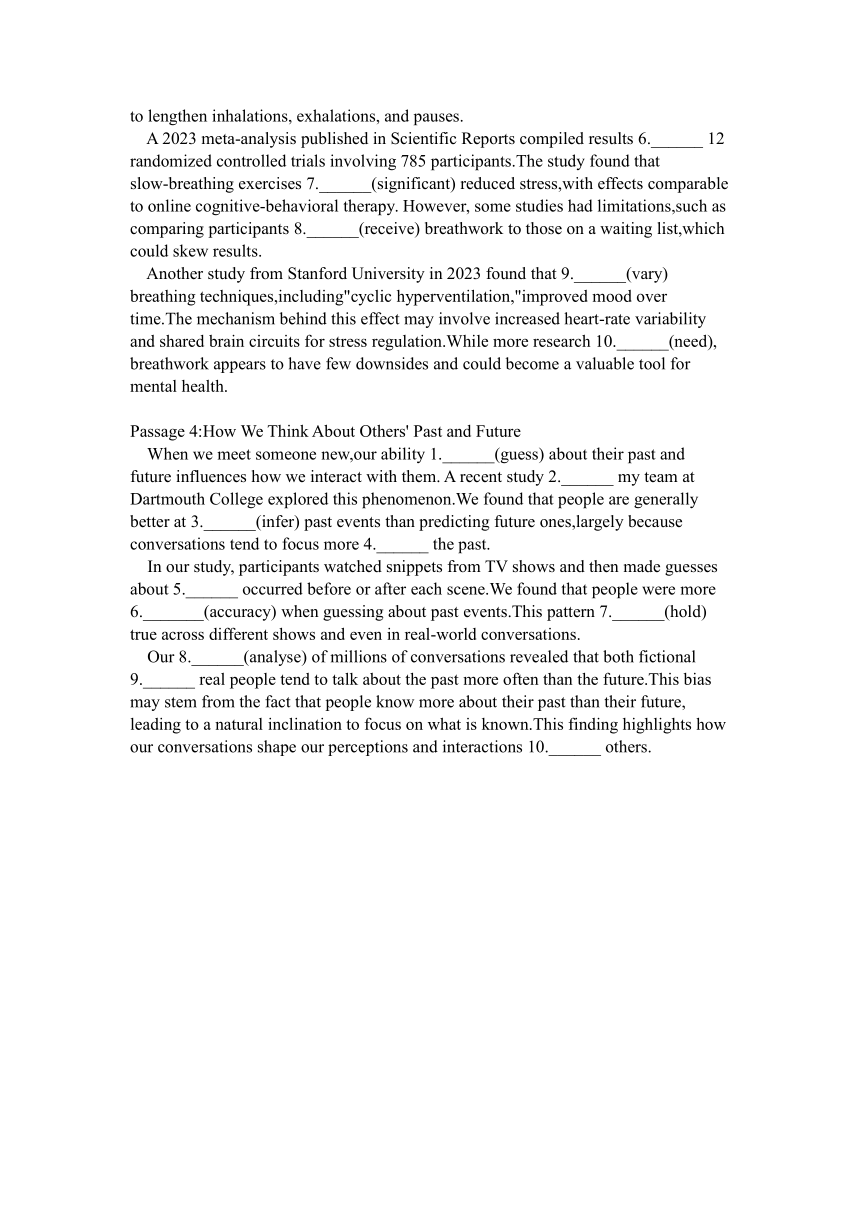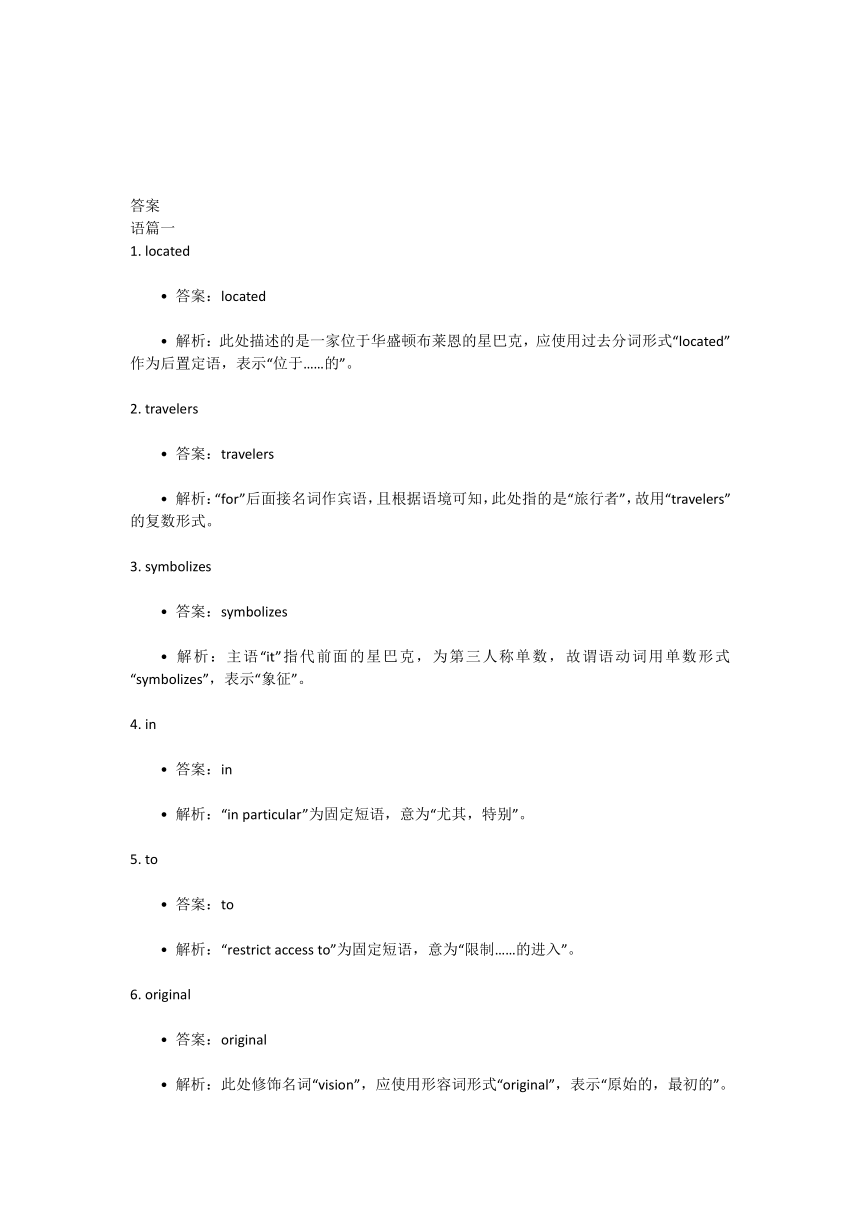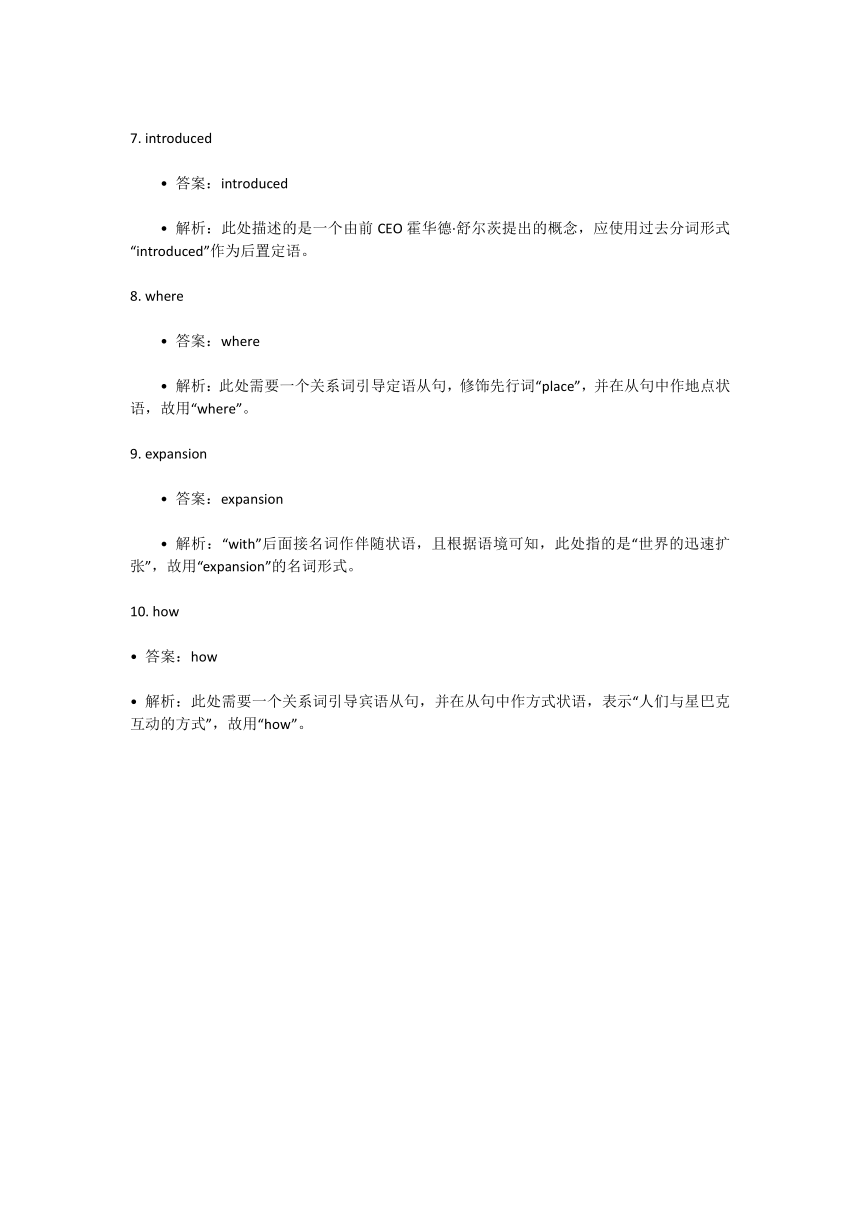2025届高三英语下学期一轮复习专项:外刊语法填空练习(星巴克第三空间、人们对Ai的看法、呼吸缓解压力、如何通过对话知道别人的过去未来)(含答案)
文档属性
| 名称 | 2025届高三英语下学期一轮复习专项:外刊语法填空练习(星巴克第三空间、人们对Ai的看法、呼吸缓解压力、如何通过对话知道别人的过去未来)(含答案) |  | |
| 格式 | docx | ||
| 文件大小 | 26.5KB | ||
| 资源类型 | 教案 | ||
| 版本资源 | 人教版(2019) | ||
| 科目 | 英语 | ||
| 更新时间 | 2025-02-01 23:01:52 | ||
图片预览




文档简介
Passage 1:The Evolution of Starbucks as a"Third Space"
In Blaine,Washington, a Starbucks 1.______(locate) near the busy Peace Arch border crossing serves as a crucial pit stop for 2.______(travel). Designed like a lighthouse overlooking Semiahmoo Bay, it 3.______(symbolize) a welcoming beacon for those entering the country.The restroom, 4.______ particular, is a vital amenity for travelers stuck in long queues at the border.
However, Starbucks' new CEO recently announced an updated "Code of Conduct," restricting access 5.______ its spaces, including restrooms, to paying customers only.This move reflects a shift from Starbucks' 6.______(origin) vision of being a "third space," a concept 7.______(introduce) by former CEO Howard Schultz. Schultz envisioned Starbucks as a place 8.______ people could gather and build community, beyond just being a coffee shop.
While this idea worked well for a time,with rapid 9.______(expand) worldwide, the rise of mobile ordering and drive-throughs has changed 10.______ people interact with Starbucks.Today, most orders are completed via apps or drive-throughs,making the in-store experience less about community and more about convenience.The new CEO, Brian Niccol, acknowledges the need to improve the in-store experience,but the balance between being a community hub and a commercial success remains a challenge.
Passage 2:The"Magic"of AI and Public Perception
New research published in the Journal of Marketing reveals a 1.______(surprise) trend:people with 2.______(little) knowledge about AI are more open to using it.This "lower literacy-higher receptivity" link shows that in countries with lower average AI literacy, people are more receptive to AI 3.______(adopt).
The reason lies in how AI performs tasks once thought 4.______(be) uniquely human, giving 5.______ a "magical" feel. People with more technical knowledge understand AI's mechanics, making it less 6.______(mystery). In contrast,those with less understanding are more awed by AI's capabilities.This link is strongest for tasks 7.______(associate) with human traits,like emotional support.
However, for tasks focusing on 8.______(efficient), higher AI literacy leads to greater receptivity.This finding poses 9.______ challenge for policymakers and educators,who must balance increasing AI literacy with maintaining public enthusiasm.Efforts 10.______(educate) the public about AI might unintentionally reduce its perceived"magic," thus dampening enthusiasm.Striking the right balance is crucial for maximizing AI's potential while keeping people engaged.
Passage 3:The Benefits of Breathwork for Stress Relief
At 7Breaths, 1.______ meditation studio in central London, groups of young professionals gather 2._____(practice) "breathwork," a form of guided breathing 3.______(aim) at reducing stress.Participants sit cross-legged on cushions,focusing on their breath 4.______ an instructor guides them through 5.______(exercise) designed to lengthen inhalations, exhalations, and pauses.
A 2023 meta-analysis published in Scientific Reports compiled results 6.______ 12 randomized controlled trials involving 785 participants.The study found that slow-breathing exercises 7.______(significant) reduced stress,with effects comparable to online cognitive-behavioral therapy. However, some studies had limitations,such as comparing participants 8.______(receive) breathwork to those on a waiting list,which could skew results.
Another study from Stanford University in 2023 found that 9.______(vary) breathing techniques,including"cyclic hyperventilation,"improved mood over time.The mechanism behind this effect may involve increased heart-rate variability and shared brain circuits for stress regulation.While more research 10.______(need), breathwork appears to have few downsides and could become a valuable tool for mental health.
Passage 4:How We Think About Others' Past and Future
When we meet someone new,our ability 1.______(guess) about their past and future influences how we interact with them. A recent study 2.______ my team at Dartmouth College explored this phenomenon.We found that people are generally better at 3.______(infer) past events than predicting future ones,largely because conversations tend to focus more 4.______ the past.
In our study, participants watched snippets from TV shows and then made guesses about 5.______ occurred before or after each scene.We found that people were more 6._______(accuracy) when guessing about past events.This pattern 7.______(hold) true across different shows and even in real-world conversations.
Our 8.______(analyse) of millions of conversations revealed that both fictional 9.______ real people tend to talk about the past more often than the future.This bias may stem from the fact that people know more about their past than their future, leading to a natural inclination to focus on what is known.This finding highlights how our conversations shape our perceptions and interactions 10.______ others.
答案
语篇一
1. located
答案:located
解析:此处描述的是一家位于华盛顿布莱恩的星巴克,应使用过去分词形式“located”作为后置定语,表示“位于……的”。
2. travelers
答案:travelers
解析:“for”后面接名词作宾语,且根据语境可知,此处指的是“旅行者”,故用“travelers”的复数形式。
3. symbolizes
答案:symbolizes
解析:主语“it”指代前面的星巴克,为第三人称单数,故谓语动词用单数形式“symbolizes”,表示“象征”。
4. in
答案:in
解析:“in particular”为固定短语,意为“尤其,特别”。
5. to
答案:to
解析:“restrict access to”为固定短语,意为“限制……的进入”。
6. original
答案:original
解析:此处修饰名词“vision”,应使用形容词形式“original”,表示“原始的,最初的”。
7. introduced
答案:introduced
解析:此处描述的是一个由前CEO霍华德·舒尔茨提出的概念,应使用过去分词形式“introduced”作为后置定语。
8. where
答案:where
解析:此处需要一个关系词引导定语从句,修饰先行词“place”,并在从句中作地点状语,故用“where”。
9. expansion
答案:expansion
解析:“with”后面接名词作伴随状语,且根据语境可知,此处指的是“世界的迅速扩张”,故用“expansion”的名词形式。
10. how
答案:how
解析:此处需要一个关系词引导宾语从句,并在从句中作方式状语,表示“人们与星巴克互动的方式”,故用“how”。
语篇二
1. 答案:surprising解析:此处需要形容词来修饰名词“trend”,而“surprise”的形容词形式有“surprised”(感到惊讶的,通常用于人)和“surprising”(令人惊讶的,通常用于物或现象)。根据语境,“a surprising trend”表示“一个令人惊讶的趋势”,因此填“surprising”。
2. 答案:less解析:此处需要比较级来与后文的“more”形成对比。根据语境,“people with less knowledge about AI are more open to using it”表示“对AI了解较少的人更愿意使用它”,因此填“less”。
3. 答案:adoption解析:此处需要名词作为“to”的宾语。根据语境,“people are more receptive to AI adoption”表示“人们更容易接受AI的采用”,因此填“adoption”(采用,接纳)。
4. 答案:to be解析:此处考查“think”的固定搭配“think sth. to be...”表示“认为某物是...”。根据语境,“once thought to be uniquely human”表示“一度被认为是人类独有的”,因此填“to be”。
5. 答案:it解析:此处需要代词作为“giving”的宾语,指代前文提到的“AI performs tasks”。由于“AI”是单数,且在此处作为非人称代词使用,因此填“it”。但需要注意的是,这里的“it”实际上是指代AI所完成的任务或能力给人的感觉,是一种抽象指代。
6. 答案:mysterious解析:此处需要形容词来修饰“it”(指代AI的某种特性)。根据语境,“making it less mysterious”表示“使其不那么神秘”,因此填“mysterious”的否定形式“less mysterious”中的形容词部分“mysterious”。
7. 答案:associated解析:此处考查过去分词作为形容词的用法,修饰名词“tasks”。根据语境,“tasks associated with human traits”表示“与人类特性相关的任务”,因此填“associated”。
8. 答案:efficiency解析:此处需要名词作为“on”的宾语。根据语境,“for tasks focusing on efficiency”表示“对于注重效率的任务”,因此填“efficiency”(效率)。
9. 答案:a解析:此处需要冠词来修饰可数名词单数“challenge”。根据语境,“poses a challenge for policymakers and educators”表示“给政策制定者和教育者带来了挑战”,因此填不定冠词“a”。
10. 答案:to educate解析:此处考查不定式作为后置定语的用法,修饰名词“Efforts”。根据语境,“Efforts to educate the public about AI”表示“教育公众了解AI的努力”,因此填“to educate”。
综上所述,填空答案依次为:surprising;less;adoption;to be;it;mysterious;associated;efficiency;a;to educate。
语篇三
1. a
解析:此处需要一个冠词来修饰单数名词“meditation studio”,且“studio”并非特指,所以用不定冠词“a”。
2. to practice
解析:“gather”后接不定式作目的状语,表示“聚集起来练习...”,所以填“to practice”。
3. aimed
解析:“guided breathing”与“aim”之间是逻辑上的被动关系,且此空在句中作后置定语修饰“guided breathing”,所以用过去分词“aimed”表被动。
4. as/while
解析:根据语境,“参与者盘腿坐在垫子上,专注于他们的呼吸,_____教练引导他们进行...”,这里需要一个连词表示“当...时”或“随着...”,所以“as”或“while”都合适。
5. exercises
解析:“exercise”在此处意为“练习(项目)”,是可数名词,且根据“designed to lengthen inhalations, exhalations, and pauses”可知,这里应该指的是多种练习,所以用复数形式“exercises”。
6. from
解析:“compiled results _____ 12 randomized controlled trials”表示“从12项随机对照试验中汇总结果”,所以填介词“from”。
7. significantly
解析:“reduced”是动词,需要副词来修饰,所以填“significantly”表示“显著地减少”。
8. receiving
解析:“comparing participants _____ breathwork to those on a waiting list”中,participants与receive之间是逻辑上的主动关系,但在此上下文中,我们更关注于参与者的状态,即“正在接受呼吸练习的参与者”,所以用现在分词“receiving”作后置定语。
9. various
解析:“_____ breathing techniques”中需要一个形容词来修饰“breathing techniques”,所以填“various”表示“不同的”。
10. is needed
解析:根据语境,“虽然还需要更多的研究”,这里描述的是一个客观事实,且主语“research”是不可数名词,所以谓语动词用单数形式“is”。同时,“research”与“need”之间是逻辑上的被动关系,所以用被动语态“is needed”。
语篇四
1. to guess
解析:此处考查的是不定式作定语,修饰名词ability。表示“猜测的能力”,所以填to guess。
2. by
解析:此处考查的是介词短语作定语,修饰名词study。表示“由我的团队进行的研究”,所以填by。
3. inferring
解析:此处考查的是介词at后的动名词形式,作为介词at的宾语。表示“擅长于推断”,所以填inferring。
4. on
解析:此处考查的是固定短语focus on,意为“集中于”。所以填on。
5. what
解析:此处考查的是宾语从句的引导词。从句中缺少主语,且表示“发生的事情”,所以填what。
6. accurate
解析:此处考查的是形容词作表语,修饰系动词were。表示“准确的”,所以填accurate。
7. held
解析:根据上下文可知,此处描述的是过去的研究结果,所以使用一般过去时。表示“这个模式在过去的研究中成立”,所以填held。
8. analysis
解析:此处考查的是名词作主语,表示“我们的分析”。analysis是analyse的名词形式,所以填analysis。
9. and
解析:此处考查的是并列连词,连接两个并列的名词短语fictional people和real people。表示“虚构的人和真实的人”,所以填and。
10. with
解析:此处考查的是固定短语interact with,意为“与……互动”。所以填with。
翻译
语篇一
在华盛顿州布兰市,一家星巴克位于繁忙的和平拱门边境口岸附近,成为旅行者的重要停留点。它被设计成一座灯塔,俯瞰着塞米阿穆湾,象征着对进入美国的人们的欢迎。星巴克的洗手间对任何人开放,尤其是那些在边境排队等待的旅行者。然而,星巴克的新CEO最近宣布更新“行为准则”,限制其空间(包括洗手间)仅限付费顾客使用。这一变化反映了星巴克从其“第三空间”的原始愿景的转变,这一概念由前CEO霍华德·舒尔茨提出,他希望星巴克成为人们聚集和建立社区的地方,而不仅仅是一个咖啡店。尽管这一理念在一段时间内奏效了,但随着星巴克在全球的快速扩张,以及移动点单和得来速的兴起,人们与星巴克的互动方式发生了变化。如今,大多数订单是通过应用程序或得来速完成的,店内体验更多地关注便利性,而不是社区感。新CEO布莱恩·尼科尔承认需要改善店内体验,但如何在成为社区中心和商业成功之间取得平衡仍然是一个挑战。语篇二《营销杂志》上发表的新研究揭示了一个令人惊讶的趋势:对人工智能(AI)了解较少的人更愿意使用它。这种“低素养—高接受度”的联系表明,在平均AI素养较低的国家,人们对AI的接受度更高。原因在于AI执行的某些任务曾经被认为只有人类才能完成,这赋予了它一种“魔力”。对AI技术有更多了解的人理解AI的运行机制,使其显得不那么神秘。相比之下,对AI了解较少的人更容易被其能力所震撼。这种联系在与人类特质相关的任务(如情感支持)中最为明显。然而,对于关注效率的任务,更高的AI素养会导致更高的接受度。这一发现对政策制定者和教育工作者提出了挑战,他们必须在提高AI素养与保持公众热情之间取得平衡。关于AI的公众教育可能会无意中减少其“魔力”,从而削弱公众的热情。在最大化AI潜力的同时保持人们的参与度,找到正确的平衡至关重要。语篇三在伦敦市中心的7Breaths冥想工作室,一群年轻的专业人士聚集在一起,练习“呼吸工作”,这是一种旨在缓解压力的引导式呼吸练习。参与者盘腿坐在垫子上,专注于呼吸,随着指导者的引导,逐渐延长吸气、呼气和暂停的时间。2023年发表在《科学报告》上的一项元分析汇总了12项随机对照试验的结果,涉及785名参与者。研究发现,慢呼吸练习显著降低了压力,效果与在线认知行为疗法相当。然而,一些研究存在局限性,例如将接受呼吸练习的参与者与等待名单上的参与者进行比较,这可能会歪曲结果。2023年斯坦福大学的另一项研究发现,包括“循环过度换气”在内的各种呼吸技巧可以随着时间的推移改善情绪。这种效果背后的机制可能涉及增加心率变异性以及与压力调节共享的脑回路。尽管还需要更多的研究,但呼吸工作似乎几乎没有缺点,可能成为心理健康的一个有价值的工具。语篇四当我们遇到一个陌生人时,我们对他人的过去和未来的猜测影响着我们与他们的互动。达特茅斯学院我的团队最近的一项研究探索了这一现象。我们发现,人们通常更擅长推断过去的事件,而不是预测未来的事件,这主要是因为对话往往更多地关注过去。在我们的研究中,参与者观看了电视剧的片段,然后猜测每个场景之前或之后发生了什么。我们发现,当猜测过去的事件时,人们更准确。这一模式在不同的电视剧中都成立,甚至在现实世界的对话中也是如此。我们对数百万次对话的分析显示,无论是虚构的还是真实的人,都倾向于更多地谈论过去而不是未来。这种偏见可能源于人们对自己过去比未来了解得更多,导致自然倾向于关注已知的事情。这一发现突显了我们的对话如何塑造我们对他人的感知和互动。
In Blaine,Washington, a Starbucks 1.______(locate) near the busy Peace Arch border crossing serves as a crucial pit stop for 2.______(travel). Designed like a lighthouse overlooking Semiahmoo Bay, it 3.______(symbolize) a welcoming beacon for those entering the country.The restroom, 4.______ particular, is a vital amenity for travelers stuck in long queues at the border.
However, Starbucks' new CEO recently announced an updated "Code of Conduct," restricting access 5.______ its spaces, including restrooms, to paying customers only.This move reflects a shift from Starbucks' 6.______(origin) vision of being a "third space," a concept 7.______(introduce) by former CEO Howard Schultz. Schultz envisioned Starbucks as a place 8.______ people could gather and build community, beyond just being a coffee shop.
While this idea worked well for a time,with rapid 9.______(expand) worldwide, the rise of mobile ordering and drive-throughs has changed 10.______ people interact with Starbucks.Today, most orders are completed via apps or drive-throughs,making the in-store experience less about community and more about convenience.The new CEO, Brian Niccol, acknowledges the need to improve the in-store experience,but the balance between being a community hub and a commercial success remains a challenge.
Passage 2:The"Magic"of AI and Public Perception
New research published in the Journal of Marketing reveals a 1.______(surprise) trend:people with 2.______(little) knowledge about AI are more open to using it.This "lower literacy-higher receptivity" link shows that in countries with lower average AI literacy, people are more receptive to AI 3.______(adopt).
The reason lies in how AI performs tasks once thought 4.______(be) uniquely human, giving 5.______ a "magical" feel. People with more technical knowledge understand AI's mechanics, making it less 6.______(mystery). In contrast,those with less understanding are more awed by AI's capabilities.This link is strongest for tasks 7.______(associate) with human traits,like emotional support.
However, for tasks focusing on 8.______(efficient), higher AI literacy leads to greater receptivity.This finding poses 9.______ challenge for policymakers and educators,who must balance increasing AI literacy with maintaining public enthusiasm.Efforts 10.______(educate) the public about AI might unintentionally reduce its perceived"magic," thus dampening enthusiasm.Striking the right balance is crucial for maximizing AI's potential while keeping people engaged.
Passage 3:The Benefits of Breathwork for Stress Relief
At 7Breaths, 1.______ meditation studio in central London, groups of young professionals gather 2._____(practice) "breathwork," a form of guided breathing 3.______(aim) at reducing stress.Participants sit cross-legged on cushions,focusing on their breath 4.______ an instructor guides them through 5.______(exercise) designed to lengthen inhalations, exhalations, and pauses.
A 2023 meta-analysis published in Scientific Reports compiled results 6.______ 12 randomized controlled trials involving 785 participants.The study found that slow-breathing exercises 7.______(significant) reduced stress,with effects comparable to online cognitive-behavioral therapy. However, some studies had limitations,such as comparing participants 8.______(receive) breathwork to those on a waiting list,which could skew results.
Another study from Stanford University in 2023 found that 9.______(vary) breathing techniques,including"cyclic hyperventilation,"improved mood over time.The mechanism behind this effect may involve increased heart-rate variability and shared brain circuits for stress regulation.While more research 10.______(need), breathwork appears to have few downsides and could become a valuable tool for mental health.
Passage 4:How We Think About Others' Past and Future
When we meet someone new,our ability 1.______(guess) about their past and future influences how we interact with them. A recent study 2.______ my team at Dartmouth College explored this phenomenon.We found that people are generally better at 3.______(infer) past events than predicting future ones,largely because conversations tend to focus more 4.______ the past.
In our study, participants watched snippets from TV shows and then made guesses about 5.______ occurred before or after each scene.We found that people were more 6._______(accuracy) when guessing about past events.This pattern 7.______(hold) true across different shows and even in real-world conversations.
Our 8.______(analyse) of millions of conversations revealed that both fictional 9.______ real people tend to talk about the past more often than the future.This bias may stem from the fact that people know more about their past than their future, leading to a natural inclination to focus on what is known.This finding highlights how our conversations shape our perceptions and interactions 10.______ others.
答案
语篇一
1. located
答案:located
解析:此处描述的是一家位于华盛顿布莱恩的星巴克,应使用过去分词形式“located”作为后置定语,表示“位于……的”。
2. travelers
答案:travelers
解析:“for”后面接名词作宾语,且根据语境可知,此处指的是“旅行者”,故用“travelers”的复数形式。
3. symbolizes
答案:symbolizes
解析:主语“it”指代前面的星巴克,为第三人称单数,故谓语动词用单数形式“symbolizes”,表示“象征”。
4. in
答案:in
解析:“in particular”为固定短语,意为“尤其,特别”。
5. to
答案:to
解析:“restrict access to”为固定短语,意为“限制……的进入”。
6. original
答案:original
解析:此处修饰名词“vision”,应使用形容词形式“original”,表示“原始的,最初的”。
7. introduced
答案:introduced
解析:此处描述的是一个由前CEO霍华德·舒尔茨提出的概念,应使用过去分词形式“introduced”作为后置定语。
8. where
答案:where
解析:此处需要一个关系词引导定语从句,修饰先行词“place”,并在从句中作地点状语,故用“where”。
9. expansion
答案:expansion
解析:“with”后面接名词作伴随状语,且根据语境可知,此处指的是“世界的迅速扩张”,故用“expansion”的名词形式。
10. how
答案:how
解析:此处需要一个关系词引导宾语从句,并在从句中作方式状语,表示“人们与星巴克互动的方式”,故用“how”。
语篇二
1. 答案:surprising解析:此处需要形容词来修饰名词“trend”,而“surprise”的形容词形式有“surprised”(感到惊讶的,通常用于人)和“surprising”(令人惊讶的,通常用于物或现象)。根据语境,“a surprising trend”表示“一个令人惊讶的趋势”,因此填“surprising”。
2. 答案:less解析:此处需要比较级来与后文的“more”形成对比。根据语境,“people with less knowledge about AI are more open to using it”表示“对AI了解较少的人更愿意使用它”,因此填“less”。
3. 答案:adoption解析:此处需要名词作为“to”的宾语。根据语境,“people are more receptive to AI adoption”表示“人们更容易接受AI的采用”,因此填“adoption”(采用,接纳)。
4. 答案:to be解析:此处考查“think”的固定搭配“think sth. to be...”表示“认为某物是...”。根据语境,“once thought to be uniquely human”表示“一度被认为是人类独有的”,因此填“to be”。
5. 答案:it解析:此处需要代词作为“giving”的宾语,指代前文提到的“AI performs tasks”。由于“AI”是单数,且在此处作为非人称代词使用,因此填“it”。但需要注意的是,这里的“it”实际上是指代AI所完成的任务或能力给人的感觉,是一种抽象指代。
6. 答案:mysterious解析:此处需要形容词来修饰“it”(指代AI的某种特性)。根据语境,“making it less mysterious”表示“使其不那么神秘”,因此填“mysterious”的否定形式“less mysterious”中的形容词部分“mysterious”。
7. 答案:associated解析:此处考查过去分词作为形容词的用法,修饰名词“tasks”。根据语境,“tasks associated with human traits”表示“与人类特性相关的任务”,因此填“associated”。
8. 答案:efficiency解析:此处需要名词作为“on”的宾语。根据语境,“for tasks focusing on efficiency”表示“对于注重效率的任务”,因此填“efficiency”(效率)。
9. 答案:a解析:此处需要冠词来修饰可数名词单数“challenge”。根据语境,“poses a challenge for policymakers and educators”表示“给政策制定者和教育者带来了挑战”,因此填不定冠词“a”。
10. 答案:to educate解析:此处考查不定式作为后置定语的用法,修饰名词“Efforts”。根据语境,“Efforts to educate the public about AI”表示“教育公众了解AI的努力”,因此填“to educate”。
综上所述,填空答案依次为:surprising;less;adoption;to be;it;mysterious;associated;efficiency;a;to educate。
语篇三
1. a
解析:此处需要一个冠词来修饰单数名词“meditation studio”,且“studio”并非特指,所以用不定冠词“a”。
2. to practice
解析:“gather”后接不定式作目的状语,表示“聚集起来练习...”,所以填“to practice”。
3. aimed
解析:“guided breathing”与“aim”之间是逻辑上的被动关系,且此空在句中作后置定语修饰“guided breathing”,所以用过去分词“aimed”表被动。
4. as/while
解析:根据语境,“参与者盘腿坐在垫子上,专注于他们的呼吸,_____教练引导他们进行...”,这里需要一个连词表示“当...时”或“随着...”,所以“as”或“while”都合适。
5. exercises
解析:“exercise”在此处意为“练习(项目)”,是可数名词,且根据“designed to lengthen inhalations, exhalations, and pauses”可知,这里应该指的是多种练习,所以用复数形式“exercises”。
6. from
解析:“compiled results _____ 12 randomized controlled trials”表示“从12项随机对照试验中汇总结果”,所以填介词“from”。
7. significantly
解析:“reduced”是动词,需要副词来修饰,所以填“significantly”表示“显著地减少”。
8. receiving
解析:“comparing participants _____ breathwork to those on a waiting list”中,participants与receive之间是逻辑上的主动关系,但在此上下文中,我们更关注于参与者的状态,即“正在接受呼吸练习的参与者”,所以用现在分词“receiving”作后置定语。
9. various
解析:“_____ breathing techniques”中需要一个形容词来修饰“breathing techniques”,所以填“various”表示“不同的”。
10. is needed
解析:根据语境,“虽然还需要更多的研究”,这里描述的是一个客观事实,且主语“research”是不可数名词,所以谓语动词用单数形式“is”。同时,“research”与“need”之间是逻辑上的被动关系,所以用被动语态“is needed”。
语篇四
1. to guess
解析:此处考查的是不定式作定语,修饰名词ability。表示“猜测的能力”,所以填to guess。
2. by
解析:此处考查的是介词短语作定语,修饰名词study。表示“由我的团队进行的研究”,所以填by。
3. inferring
解析:此处考查的是介词at后的动名词形式,作为介词at的宾语。表示“擅长于推断”,所以填inferring。
4. on
解析:此处考查的是固定短语focus on,意为“集中于”。所以填on。
5. what
解析:此处考查的是宾语从句的引导词。从句中缺少主语,且表示“发生的事情”,所以填what。
6. accurate
解析:此处考查的是形容词作表语,修饰系动词were。表示“准确的”,所以填accurate。
7. held
解析:根据上下文可知,此处描述的是过去的研究结果,所以使用一般过去时。表示“这个模式在过去的研究中成立”,所以填held。
8. analysis
解析:此处考查的是名词作主语,表示“我们的分析”。analysis是analyse的名词形式,所以填analysis。
9. and
解析:此处考查的是并列连词,连接两个并列的名词短语fictional people和real people。表示“虚构的人和真实的人”,所以填and。
10. with
解析:此处考查的是固定短语interact with,意为“与……互动”。所以填with。
翻译
语篇一
在华盛顿州布兰市,一家星巴克位于繁忙的和平拱门边境口岸附近,成为旅行者的重要停留点。它被设计成一座灯塔,俯瞰着塞米阿穆湾,象征着对进入美国的人们的欢迎。星巴克的洗手间对任何人开放,尤其是那些在边境排队等待的旅行者。然而,星巴克的新CEO最近宣布更新“行为准则”,限制其空间(包括洗手间)仅限付费顾客使用。这一变化反映了星巴克从其“第三空间”的原始愿景的转变,这一概念由前CEO霍华德·舒尔茨提出,他希望星巴克成为人们聚集和建立社区的地方,而不仅仅是一个咖啡店。尽管这一理念在一段时间内奏效了,但随着星巴克在全球的快速扩张,以及移动点单和得来速的兴起,人们与星巴克的互动方式发生了变化。如今,大多数订单是通过应用程序或得来速完成的,店内体验更多地关注便利性,而不是社区感。新CEO布莱恩·尼科尔承认需要改善店内体验,但如何在成为社区中心和商业成功之间取得平衡仍然是一个挑战。语篇二《营销杂志》上发表的新研究揭示了一个令人惊讶的趋势:对人工智能(AI)了解较少的人更愿意使用它。这种“低素养—高接受度”的联系表明,在平均AI素养较低的国家,人们对AI的接受度更高。原因在于AI执行的某些任务曾经被认为只有人类才能完成,这赋予了它一种“魔力”。对AI技术有更多了解的人理解AI的运行机制,使其显得不那么神秘。相比之下,对AI了解较少的人更容易被其能力所震撼。这种联系在与人类特质相关的任务(如情感支持)中最为明显。然而,对于关注效率的任务,更高的AI素养会导致更高的接受度。这一发现对政策制定者和教育工作者提出了挑战,他们必须在提高AI素养与保持公众热情之间取得平衡。关于AI的公众教育可能会无意中减少其“魔力”,从而削弱公众的热情。在最大化AI潜力的同时保持人们的参与度,找到正确的平衡至关重要。语篇三在伦敦市中心的7Breaths冥想工作室,一群年轻的专业人士聚集在一起,练习“呼吸工作”,这是一种旨在缓解压力的引导式呼吸练习。参与者盘腿坐在垫子上,专注于呼吸,随着指导者的引导,逐渐延长吸气、呼气和暂停的时间。2023年发表在《科学报告》上的一项元分析汇总了12项随机对照试验的结果,涉及785名参与者。研究发现,慢呼吸练习显著降低了压力,效果与在线认知行为疗法相当。然而,一些研究存在局限性,例如将接受呼吸练习的参与者与等待名单上的参与者进行比较,这可能会歪曲结果。2023年斯坦福大学的另一项研究发现,包括“循环过度换气”在内的各种呼吸技巧可以随着时间的推移改善情绪。这种效果背后的机制可能涉及增加心率变异性以及与压力调节共享的脑回路。尽管还需要更多的研究,但呼吸工作似乎几乎没有缺点,可能成为心理健康的一个有价值的工具。语篇四当我们遇到一个陌生人时,我们对他人的过去和未来的猜测影响着我们与他们的互动。达特茅斯学院我的团队最近的一项研究探索了这一现象。我们发现,人们通常更擅长推断过去的事件,而不是预测未来的事件,这主要是因为对话往往更多地关注过去。在我们的研究中,参与者观看了电视剧的片段,然后猜测每个场景之前或之后发生了什么。我们发现,当猜测过去的事件时,人们更准确。这一模式在不同的电视剧中都成立,甚至在现实世界的对话中也是如此。我们对数百万次对话的分析显示,无论是虚构的还是真实的人,都倾向于更多地谈论过去而不是未来。这种偏见可能源于人们对自己过去比未来了解得更多,导致自然倾向于关注已知的事情。这一发现突显了我们的对话如何塑造我们对他人的感知和互动。
